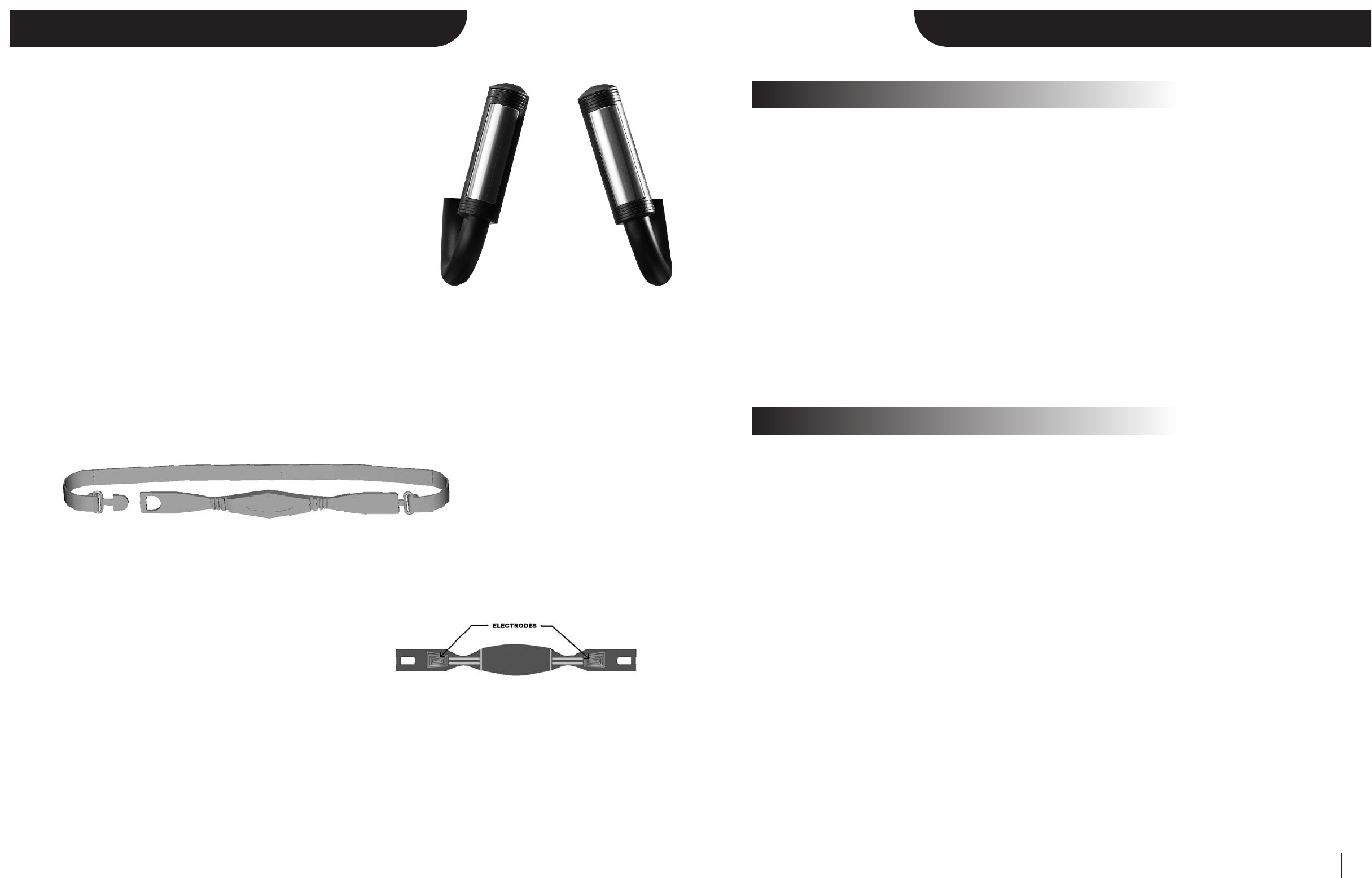
24
Getting the Most Out of Your Workouts
23
Heart Rate Monitors
Every ElliptiMill comes with AccuTrack Contact Heart Rate Grips that can be
used in place of the wireless chest strap.
CONTACT GRIPS (shown on right)
To use the Contact Grips follow these steps:
Grab the contact grips.
The center display will start flashing to communicate that the system is active
and acquiring a signal.
After about 5-10 seconds, your heart rate will be displayed and remain
displayed as long as you hold on to the grips.
Once you release them, the display will automatically revert to the statistic
displayed prior to grabbing the grips.
Note: If you are wearing the wireless chest strap, the AccuTrack Contact Heart Rate Grips will override the wireless signal
while your hands are on the grips. Once you release the grips, the elliptical will default back to the wireless signal.
The contact grips are designed to reliably operate up to approximately 70 RPM. Higher speeds can cause the user’s hands to
shift and hinder the heart rate signal acquisition. For the most reliable results, use the wireless chest strap.
WIRELESS HEART RATE CHEST STRAP TRANSMITTER (shown below)
To use the Wireless Chest Strap follow these steps:
SECURE THE CHEST STRAP
Center the transmitter on the chest as high under the pectoral muscles (breasts) as possible. Tighten the strap so that the
belt is as tight as possible without being uncomfortable.
APPLY CARDIO GEL TO THE ELECTRODES
A tube of Landice Cardio Gel was shipped with your ElliptiMill. Pull
the belt away from your chest and apply a small dab to each electrode.
This will ensure a strong electrical contact between the transmitter
and your chest.
The Heart Rate Transmitter works best against bare skin. Since sweat (saltwater) is an electrical conductor, the transmitter
will work over a T-shirt if the shirt is wet with sweat. If you are having trouble getting an accurate pulse reading, try wearing
the belt against bare skin.
CARE AND MAINTENANCE
The transmitter activates when the belt is properly wetted. In order to conserve battery life, wipe the electrodes dry when
not in use. Clean monthly with mild soap and water and wipe dry. Do not use abrasives in cleaning, as they can cause per-
manent damage to the electrodes. Do not bend or stretch the electrode strips, especially when storing the belt transmitter.
Using Heart Rate Monitors
Workout Tips
KEEPS YOU SAFE
Exercising too hard can put you at risk for injury. A heart rate monitor reminds you of the safe and effective heart rate
intensity at which you should exercise and warns you when your workouts go too far.
KEEPS YOU IN YOUR ZONE
If you want to reach your exercise goals, it’s important to stay in your THRZ during workouts. A heart rate monitor is your
constant reminder of the intensity and quality of each workout session.
SAVES YOU TIME
Our heart rate monitor is wireless and easy to use, so you can view valuable heart rate information at any time during
exercise without interrupting or stopping your workout.
GIVES YOU ACCURATE FEEDBACK
Our heart rate monitor is more accurate so you know exactly what your level of exercise intensity is during workouts.
Pulsemeters have a high margin for error. Manual pulse measurements during exercise can result in errors as high as plus or
minus 15 beats per minute, with the risk of potential error increasing as heart rate increases.
The ElliptiMill includes two separate heart rate monitoring systems: The Wireless Heart Rate Chest Strap Transmitter and
the AccuTrack Contact Grips.
FREQUENCY OF EXERCISE
Exercise 3-5 times a week; 20-60 minutes per day.
DURING YOUR WORKOUT
• Monitor your breathing. Can you carry on a normal conversation or are you out of breath? If you use the heart rate
method of monitoring intensity, are you within the heart rate zone?
• Change the speed and effort level as needed to stay within the breathing and heart rate criteria.
AFTER YOUR WORKOUT
• Drink a large glass of water (you’ll recover faster).
• Do some light stretching exercises.
• Record that you completed the workout on your calendar.
KEEPING TRACK OF PROGRESS
• Keep a calendar that shows scheduled and actual workouts.
• Record every workout you complete.
• Compare planned with actual workouts completed. Aim for 90% completion. If you’re averaging less than 90%,
reevaluate your schedule and examine why you’re missing 10% of your workouts (and the extra benefits from those
missing workouts).
CALORIE COMPUTATIONS
• Calories and calories/hour are calculated using the formulas developed by the ACSM.
• The computations are based on a 150-pound person, which is a close enough estimate for most people. If you wish the
equations to be more precise, you may enter your weight into the elliptical (see Getting Started).


















